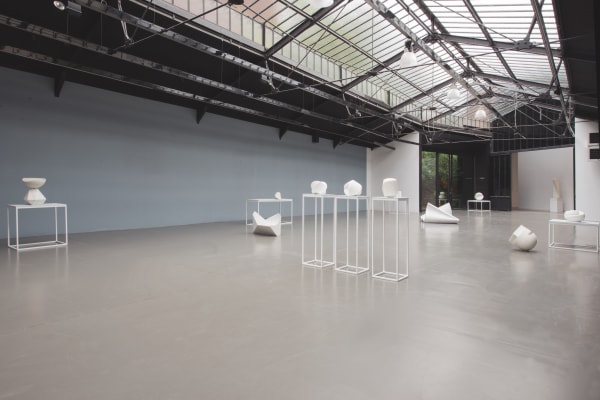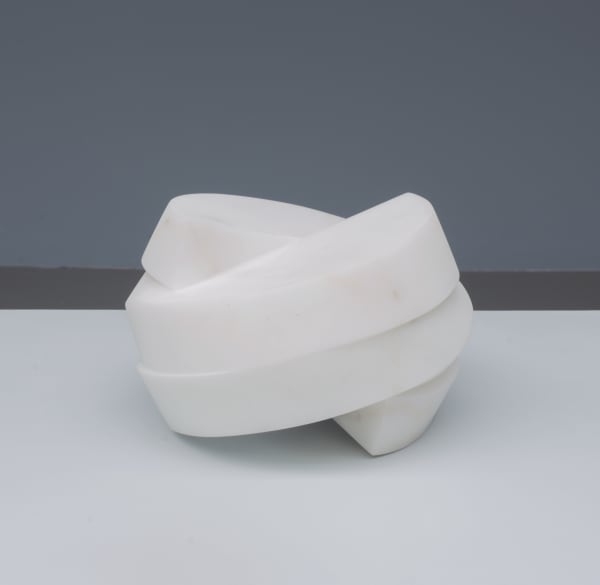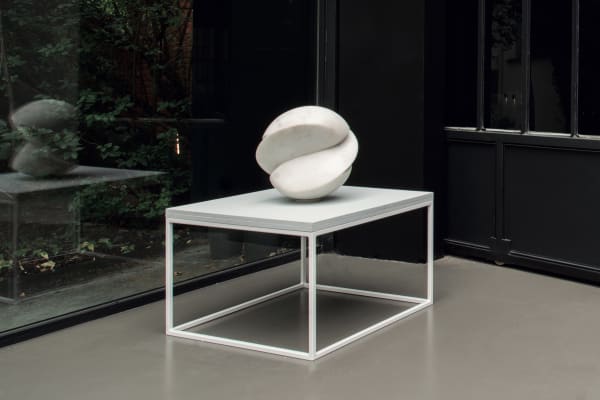INFINITE END: JAN DRIES
PAST exhibition
Overview
There are those projects that are born without any conscious planning, so utterly natural seems to be their gestation, their concept and finally their realization. The exhibition Infinite End, dedicated to the Belgian sculptor Jan Dries, is one of these. In this respect it is absolutely consistent with the artist’s work itself, true and perfectly coherent.
For his first major exhibition in Brussels, and after his departure for his last great voyage of initiation, the artist appears to have aligned the elements and stars from the Above, into a harmonious conspiracy to bring about what could be called a ‘spiritual retrospective’, a review of his thinking in stone.
Visitors are invited to view his entire oeuvre, having previously had the possibility to admire his work at the exhibition Sculpting Belgium at La Patinoire Royale in 2017. In terms of evolution, a remarkable coherence in his work has to be acknowledged, if the different pieces assembled here were to be put together chronologically, starting in the 1960’s: everything is comprehended, summed up and brought to completion, right from the start. What is particularly striking is the mastery of marble, our artist’s preferred medium, as can be seen in his first pieces.
It is a characteristic of geniuses to establish their main lines of investigation early on in their careers, artistic or otherwise, which will determine their practice throughout their lives, questing endlessly through the very nature of their thinking and artistic expression.
For the chisel of Jan Dries does not in fact, sculpt the marble: it gives shape and form to the thought, always original and sustained, which inhabits every one of his works. More than just a sculptor, Jan Dries was a thinker, a philosopher who was searching for the most perfect expression of the spirit in an essentially unrestricted form, being free from all functional expectations, which in his case was also intuition.
No tricks, no repetition, no error. Jan, like an arrow flying to the center of the target, in the hurtling dynamic of the line, with the concentration and precision of contained force, goes straight to the mark with no hesitation. His sculpture is above all a reflection, and constitutes as it were the culmination of a long spiritual maturation, the final act of a long period of gestation.
In this respect, the sculpture of Jan Dries links hands with the musician who is thinking of his note, his chord, before touching a key or string, wanting it to be right and perfect; it is this thought that breathes life into the music, not the sound as such. Stone, chisel, harness, studio … are but the material props of thought in action, always with reasoning and a permanent state of renewal.
The sculpture of Jan Dries follows the tradition of the great Early Cycladic pre-Greek marbles, where economy of means and conceptual unity ARE the form. Polishing Carrara marble to rival the satin smoothness of human skin, refining the edges and thickness to breaking point, and thus allowing the light to illuminate the interior, his works are the height of sensitivity and sensuality.
Carrara, whose name can even be seen in the word ‘carrière’, (quarry), became his personal Holy Grail, the theatre place of his own ‘carrière’ (career): he moved there in 19.. where he found the strength of his inspiration, and legitimacy in his approach and essence (in sense too!) of his initiation as a sculptor. Seizing with both hands this subtle, cold and capricious material, he entered communion with his illustrious predecessors in feeling, sometimes through suffering, the same physical emotions as those anonymous sculptors in Republican Roman portraiture. Michelangelo and Bernini were his wise guiding counselors and the living friendships made in the quarry, in the studio and also in the small community of sculptors that formed around this mine of light open to the sky, modeled him too, as if he were under an invisible chisel, drenched in humanity, generosity and sincerity. A triple buttress for artistic creation.
Intuition seemed, as with scientific invention, to be the motor behind his work. He would sense a form, work it out, draw it, and imagine it in his perceptive head: out of this would come a priori a perfectly unimaginable form, as it can only be verified a posteriori after its creation – its ‘realization’, that is to say, made real through the act of sculpting.
Frequently his sculptures play with ungainly curves, that is forms and volumes that the mind cannot imagine a priori, but which find their expression through the act of creation that gives them form. The artist teases our minds and our perception as in play on words. He surprises us and bewitches us by means of tautological forms (of which the parts refer to the whole) or infinite edges forming one and the same curve. These games of prisms or veiled volumes, complex entanglements of combined elements in variable wholes, these helical surfaces that come together, separated by space that becomes material, are just so many variations on a same metaphysical theme: charting the complexity of Creation without ever compromising the apparent and evident simplicity.
The contemplation of Jan Dries’ work brings a sense of plenitude mingled with satisfaction, similar to observing the perfection of a spiral shell or a snowflake crystal. In this way, Dries appears to want to help us clarify the relationship of mankind to the world, in a new sculptural phenomenology, studying the phenomena of perception through living an unprecedented visual and tactile sensorial experience, which also interprets an awareness of the self and the world.
In presenting this retrospective at the same time as the wide encompassing PAINTING BELGIUM dedicated to the abstract movement in Belgian painting during the years 1945-1975, la Patinoire Royale-Galerie Valérie Bach intends to broaden the field of abstraction to include its sculpted form, treated here by Dries at the highest level.
Enough cannot be said of the tribute owed by the gallery to the Jan Dries ‘Estate’, which since the artist’s death, has furthered and expanded the sculptor’s great work. The three of them, Jet, Mieke and Pieter form a trinity: tri-unitas, three distinct entities forming a perfect unity. The first is Jan’s spouse, the second his daughter and the third is both brother of the former and husband of the latter.
May each one of us see in this filigree of inter-personal relationships, the most perfect incarnation of the testament and thought of Jan Dries, placing even in the love of those closest to him, the subtlety of his thought in a work of triangular and binding human form.
For his first major exhibition in Brussels, and after his departure for his last great voyage of initiation, the artist appears to have aligned the elements and stars from the Above, into a harmonious conspiracy to bring about what could be called a ‘spiritual retrospective’, a review of his thinking in stone.
Visitors are invited to view his entire oeuvre, having previously had the possibility to admire his work at the exhibition Sculpting Belgium at La Patinoire Royale in 2017. In terms of evolution, a remarkable coherence in his work has to be acknowledged, if the different pieces assembled here were to be put together chronologically, starting in the 1960’s: everything is comprehended, summed up and brought to completion, right from the start. What is particularly striking is the mastery of marble, our artist’s preferred medium, as can be seen in his first pieces.
It is a characteristic of geniuses to establish their main lines of investigation early on in their careers, artistic or otherwise, which will determine their practice throughout their lives, questing endlessly through the very nature of their thinking and artistic expression.
For the chisel of Jan Dries does not in fact, sculpt the marble: it gives shape and form to the thought, always original and sustained, which inhabits every one of his works. More than just a sculptor, Jan Dries was a thinker, a philosopher who was searching for the most perfect expression of the spirit in an essentially unrestricted form, being free from all functional expectations, which in his case was also intuition.
No tricks, no repetition, no error. Jan, like an arrow flying to the center of the target, in the hurtling dynamic of the line, with the concentration and precision of contained force, goes straight to the mark with no hesitation. His sculpture is above all a reflection, and constitutes as it were the culmination of a long spiritual maturation, the final act of a long period of gestation.
In this respect, the sculpture of Jan Dries links hands with the musician who is thinking of his note, his chord, before touching a key or string, wanting it to be right and perfect; it is this thought that breathes life into the music, not the sound as such. Stone, chisel, harness, studio … are but the material props of thought in action, always with reasoning and a permanent state of renewal.
The sculpture of Jan Dries follows the tradition of the great Early Cycladic pre-Greek marbles, where economy of means and conceptual unity ARE the form. Polishing Carrara marble to rival the satin smoothness of human skin, refining the edges and thickness to breaking point, and thus allowing the light to illuminate the interior, his works are the height of sensitivity and sensuality.
Carrara, whose name can even be seen in the word ‘carrière’, (quarry), became his personal Holy Grail, the theatre place of his own ‘carrière’ (career): he moved there in 19.. where he found the strength of his inspiration, and legitimacy in his approach and essence (in sense too!) of his initiation as a sculptor. Seizing with both hands this subtle, cold and capricious material, he entered communion with his illustrious predecessors in feeling, sometimes through suffering, the same physical emotions as those anonymous sculptors in Republican Roman portraiture. Michelangelo and Bernini were his wise guiding counselors and the living friendships made in the quarry, in the studio and also in the small community of sculptors that formed around this mine of light open to the sky, modeled him too, as if he were under an invisible chisel, drenched in humanity, generosity and sincerity. A triple buttress for artistic creation.
Intuition seemed, as with scientific invention, to be the motor behind his work. He would sense a form, work it out, draw it, and imagine it in his perceptive head: out of this would come a priori a perfectly unimaginable form, as it can only be verified a posteriori after its creation – its ‘realization’, that is to say, made real through the act of sculpting.
Frequently his sculptures play with ungainly curves, that is forms and volumes that the mind cannot imagine a priori, but which find their expression through the act of creation that gives them form. The artist teases our minds and our perception as in play on words. He surprises us and bewitches us by means of tautological forms (of which the parts refer to the whole) or infinite edges forming one and the same curve. These games of prisms or veiled volumes, complex entanglements of combined elements in variable wholes, these helical surfaces that come together, separated by space that becomes material, are just so many variations on a same metaphysical theme: charting the complexity of Creation without ever compromising the apparent and evident simplicity.
The contemplation of Jan Dries’ work brings a sense of plenitude mingled with satisfaction, similar to observing the perfection of a spiral shell or a snowflake crystal. In this way, Dries appears to want to help us clarify the relationship of mankind to the world, in a new sculptural phenomenology, studying the phenomena of perception through living an unprecedented visual and tactile sensorial experience, which also interprets an awareness of the self and the world.
In presenting this retrospective at the same time as the wide encompassing PAINTING BELGIUM dedicated to the abstract movement in Belgian painting during the years 1945-1975, la Patinoire Royale-Galerie Valérie Bach intends to broaden the field of abstraction to include its sculpted form, treated here by Dries at the highest level.
Enough cannot be said of the tribute owed by the gallery to the Jan Dries ‘Estate’, which since the artist’s death, has furthered and expanded the sculptor’s great work. The three of them, Jet, Mieke and Pieter form a trinity: tri-unitas, three distinct entities forming a perfect unity. The first is Jan’s spouse, the second his daughter and the third is both brother of the former and husband of the latter.
May each one of us see in this filigree of inter-personal relationships, the most perfect incarnation of the testament and thought of Jan Dries, placing even in the love of those closest to him, the subtlety of his thought in a work of triangular and binding human form.
– Constantin Chariot
Installation Views











